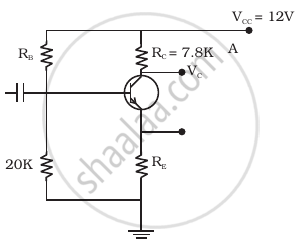Advertisements
Advertisements
प्रश्न
Answer the following question.
Draw the circuit arrangement for studying the output characteristics of an n-p-n transistor in CE configuration. Explain how the output characteristics is obtained.
उत्तर
Circuit arrangement for studying the output characteristics of an n-p-n transistor in CE configuration

Variation of collector current IC with the collector − Emitter voltage VCE is called output characteristics

The output characteristics describe the relationship between output current (IC) and output voltage (VCE).
First, draw a vertical line and a horizontal line. The vertical line represents the y-axis and horizontal line represents x-axis. The output current or collector current (IC) is taken along the y-axis (vertical line) and the output voltage (VCE) is taken along the x-axis (horizontal line).
To determine the output characteristics, the input current or base current IB is kept constant at 0 μA and the output voltage
VCE is increased from zero volts to different voltage levels. For each level of the output voltage, the corresponding output current (IC) is recorded.
A curve is then drawn between output current IC and output voltage VCE at constant input current IB (0 μA).
APPEARS IN
संबंधित प्रश्न
Draw a simple circuit of a CE transistor amplifier. Explain its working ?
Show that the voltage gain, AV, of the amplifier is given by `A_v = (beta_(ac) R_1)/r_i`where βac is the current gain, RL is the load resistance and ri is the input resistance of the transistor. What is the significance of the negative sign in the expression for the voltage gain?
Let iE, iC and iB represent the emitter current, the collector current and the base current respectively in a transistor. Then
(a) iC is slightly smaller than iE
(b) iC is slightly greater than iE
(c) iB is much smaller than iE
(d) iB is much greater than iE.
In a normal operation of a transistor,
(a) the base−emitter junction is forward-baised
(b) the base−collector junction is forward-baised
(c) the base−emitter junction is reverse-baised
(d) the base−collector junction is reverse-baised.
Draw a circuit diagram of an n-p-n transistor with its emitter-base junction forward biased and basecollector junction reverse biased. Briefly describe its working.
Explain how a transistor in its active state exhibits a low resistance at its emitter-base junction and high resistance at its base-collector junction.
Derive the expression for the voltage gain of a transistor amplifier in CE configuration in terms of the load resistance RL, current gain a βa and input resistance.
Explain why input and output voltages are in opposite phase.
Draw a circuit diagram of an n-p-n transistor with its emitter-base junction forward biased and base-collector junction reverse biased. Briefly describe its working.
Explain how a transistor in its active state exhibits a low resistance at its emitter-base junction and high resistance at its base-collector junction.
Derive the expression for the voltage gain of a transistor amplifier in CE configuration in terms of the load resistance RL, current gain βa and input resistance.
Explain why input and output voltages are in the opposite phase.
For the transistor circuit shown in figure, evaluate VE, RB, RE given IC = 1 mA, VCE = 3 V, VBE = 0.5 V and VCC = 12 V, β = 100.

